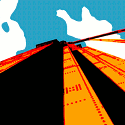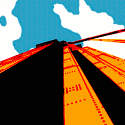the rhetoric of equestrian bronzes
…in which we start installing the power plant and have a few more bright ideas.
Jacob and I have been getting around to installing ccHost — the server engine behind ccMixter — on the wiki site for the last two weeks, in between everything else we’ve both been doing. Slow but steady seems to be the motto there. The database is created, the engine files and scripts uploaded, and then today we were completely stalled by the need to create database users. Well, patience, it’s still looking promising and we’re still learning a lot.
Meanwhile travel and dog walking have borne some strange (but good!) fruit:
- improvised transducing devices (ITDs). We’ve conducted the first field test of a contact microphone made from a set of United Airlines earbuds. Preparing for a business trip to Portugal, I grabbed the Sony PCM-D50 and Schertler microphone but forgot one key accessory: the 2.5mm to XLR-F adapter cord! I’d determined the compact cord used for stereo mics was a disaster with the Schertler due to a floating shield (hummmmm!), and the replacement mono cord is bulky so it never made it into the travel kit. In my hotel room getting ready to record around the Lisbon harbor, I found myself with plenty of cheap headphones and no usable contact mic! The Schertler putty on a pair of earbuds served pretty well, though recordings are marred by a lot of wind noise. A little more refinement and we’ll post instructions to the wiki.
- a new bridge to catalog. While in Lisbon we got a chance to sail (well, motor, actually) beneath the 25 de Avril Bridge spanning the Tagus River. There are six lanes — two made of open gridded steel, like the Brooklyn Bridge — with two railway tracks beneath. The “peculiar hum” of cars crossing is already available on Wikipedia, but when the trains go across — they did so twice as we passed underneath — this thing really howls. It’s unclear whether pedestrian access is possible (let us know!). No toll either direction in August (per Wikipedia)! For those nautically inclined, the vessel is the Leão Holandês, a hundred-year old three-master (converted from two masts in 1923) originally from Holland and available for charter.
- the rhetoric of equestrian bronzes. We’ve introduced the concept of sound mapping the world of metal statuary to the wiki site [Update 2020-04-20: see project page The Rhetoric of Equestrian Bronzes]. Coupled with the ITD concept and (possibly) wideband voice using G.722 codecs — coming soon to a mobile phone near you! — this could be a quick and efficient way to collect and present sound maps of almost anything. The inspiration comes in part from the BBC’s Save Our Sounds project [Update 02 2020-04-20: BBC has mothballed the site]. One challenge remains: getting the mic onto the statue if it’s mounted on a granite monolith.
- big woofing trucks! Jacob’s dog walk today included an engineered encounter with the Long Beach – Signal Hill Geophysical Survey [Update 03 2020-12-02: Yet another retired site!] vibration trucks using sonic reflection to map faults and oil deposits located beneath the city streets. About four minutes of audio and some photos — soon to be on Jake’s FlickR photostream — resulted. There’s already another video on Flickr but it appears to be a cell-phone recording and has been made “private”; we want the whole swept base line. It’s hard to imagine what kind of home audio investment is needed to reproduce sounds that are visible as waves in concrete, but we need to try!


